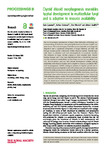Chytrid rhizoid morphogenesis resembles hyphal development in multicellular fungi and is adaptive to resource availability
| dc.contributor.author | Laundon, D | |
| dc.contributor.author | Chrismas, N | |
| dc.contributor.author | Wheeler, G | |
| dc.contributor.author | Cunliffe, Michael | |
| dc.date.accessioned | 2020-07-15T09:44:20Z | |
| dc.date.available | 2020-07-15T09:44:20Z | |
| dc.date.issued | 2020-06-10 | |
| dc.identifier.issn | 0962-8452 | |
| dc.identifier.issn | 1471-2954 | |
| dc.identifier.other | ARTN 20200433 | |
| dc.identifier.uri | http://hdl.handle.net/10026.1/16030 | |
| dc.description.abstract |
<jats:p>Key to the ecological prominence of fungi is their distinctive cell biology, our understanding of which has been principally based on dikaryan hyphal and yeast forms. The early-diverging Chytridiomycota (chytrids) are ecologically important and a significant component of fungal diversity, yet their cell biology remains poorly understood. Unlike dikaryan hyphae, chytrids typically attach to substrates and feed osmotrophically via anucleate rhizoids. The evolution of fungal hyphae appears to have occurred from rhizoid-bearing lineages and it has been hypothesized that a rhizoid-like structure was the precursor to multicellular hyphae. Here, we show in a unicellular chytrid,<jats:italic>Rhizoclosmatium globosum</jats:italic>, that rhizoid development exhibits striking similarities with dikaryan hyphae and is adaptive to resource availability. Rhizoid morphogenesis exhibits analogous patterns to hyphal growth and is controlled by β-glucan-dependent cell wall synthesis and actin polymerization. Chytrid rhizoids growing from individual cells also demonstrate adaptive morphological plasticity in response to resource availability, developing a searching phenotype when carbon starved and spatial differentiation when interacting with particulate organic matter. We demonstrate that the adaptive cell biology and associated developmental plasticity considered characteristic of hyphal fungi are shared more widely across the Kingdom Fungi and therefore could be conserved from their most recent common ancestor.</jats:p> | |
| dc.format.extent | 20200433-20200433 | |
| dc.format.medium | Print-Electronic | |
| dc.language | en | |
| dc.language.iso | en | |
| dc.publisher | The Royal Society | |
| dc.subject | chytrids | |
| dc.subject | rhizoid | |
| dc.subject | hyphae | |
| dc.subject | morphogenesis | |
| dc.subject | plasticity | |
| dc.subject | fungi | |
| dc.title | Chytrid rhizoid morphogenesis resembles hyphal development in multicellular fungi and is adaptive to resource availability | |
| dc.type | journal-article | |
| dc.type | Journal Article | |
| dc.type | Research Support, Non-U.S. Gov't | |
| plymouth.author-url | https://www.webofscience.com/api/gateway?GWVersion=2&SrcApp=PARTNER_APP&SrcAuth=LinksAMR&KeyUT=WOS:000543545100001&DestLinkType=FullRecord&DestApp=ALL_WOS&UsrCustomerID=11bb513d99f797142bcfeffcc58ea008 | |
| plymouth.issue | 1928 | |
| plymouth.volume | 287 | |
| plymouth.publication-status | Published | |
| plymouth.journal | Proceedings of the Royal Society B: Biological Sciences | |
| dc.identifier.doi | 10.1098/rspb.2020.0433 | |
| plymouth.organisational-group | /Plymouth | |
| plymouth.organisational-group | /Plymouth/Faculty of Science and Engineering | |
| plymouth.organisational-group | /Plymouth/Faculty of Science and Engineering/School of Biological and Marine Sciences | |
| plymouth.organisational-group | /Plymouth/REF 2021 Researchers by UoA | |
| plymouth.organisational-group | /Plymouth/REF 2021 Researchers by UoA/UoA07 Earth Systems and Environmental Sciences | |
| plymouth.organisational-group | /Plymouth/Users by role | |
| plymouth.organisational-group | /Plymouth/Users by role/Academics | |
| dc.publisher.place | England | |
| dcterms.dateAccepted | 2020-05-15 | |
| dc.rights.embargodate | 2020-7-16 | |
| dc.identifier.eissn | 1471-2954 | |
| dc.rights.embargoperiod | Not known | |
| rioxxterms.versionofrecord | 10.1098/rspb.2020.0433 | |
| rioxxterms.licenseref.uri | http://www.rioxx.net/licenses/all-rights-reserved | |
| rioxxterms.licenseref.startdate | 2020-06-10 | |
| rioxxterms.type | Journal Article/Review |


